Traditional “next step” narratives do not adequately support the evolving needs of today’s students. To meet their needs, and the growing demands of our globalized workforce, academic environments need to appeal to students’ individual interests and encourage career intersectionality.
By focusing on their interests, their native use of technology and the value of project-based learning, effective design can motivate students to find their own distinct paths to employment and success. Through innovative space planning, acknowledging the need for integrated technology and subsequently creating malleable environments that support experiential learning and cross-curriculum exploration, designers can contribute significantly to educational experiences.
Research suggests that science, technology, engineering, art and mathematics (STEAM) and career and technical education (CTE) environments, which support hands-on learning, “prepare students specifically for careers by mixing factual and experiential knowledge” and are a “major catalyst for teaching not only foundational STEAM, tech and CTE concepts, but life skills such as problem-solving, creativity, critical thinking, manual dexterity and spatial perception.” (Crawford 2006; Eisenberg 1998)
At CPL, we believe high-performance spaces are critical in facilitating student growth and bridging the gap between graduation and employment or higher education. Working with our clients in K-12 districts across the country[JH1] , we have seen the positive impact these spaces have on learning, teaching, enrollment and graduation success. Throughout our development and design processes, we have identified four key design elements that we believe activate this change.
Four Key Design Elements for STEAM and CTE Programs
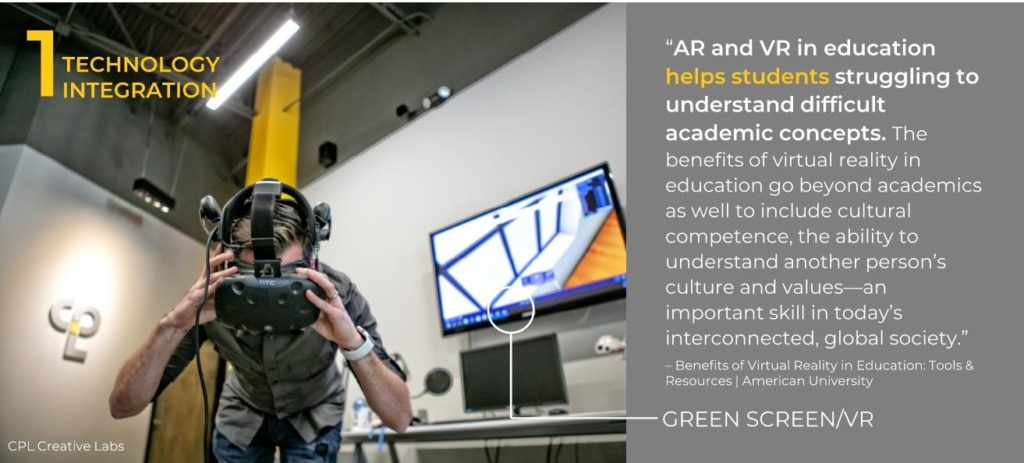
Technology Integration
Today’s students are native technology users, meaning they have never been without a streaming device, a cell phone or a laptop—these are their vehicles for receiving information, learning and exploring. Having prompt and immediate access to technology is therefore imperative for both learning and teaching environments, and we must scaffold students and educators by seamlessly integrating these elements into the changing academic landscape.
Effective integration may include providing reliable Wi-Fi access and charging stations for one-to-one devices. These simple design elements will encourage students to learn wherever they can plug-in, promoting an environment which supports free choice and enabling each student to learn in a way that makes sense to them, whether that be through individual or group study, sitting, standing or moving throughout the day.
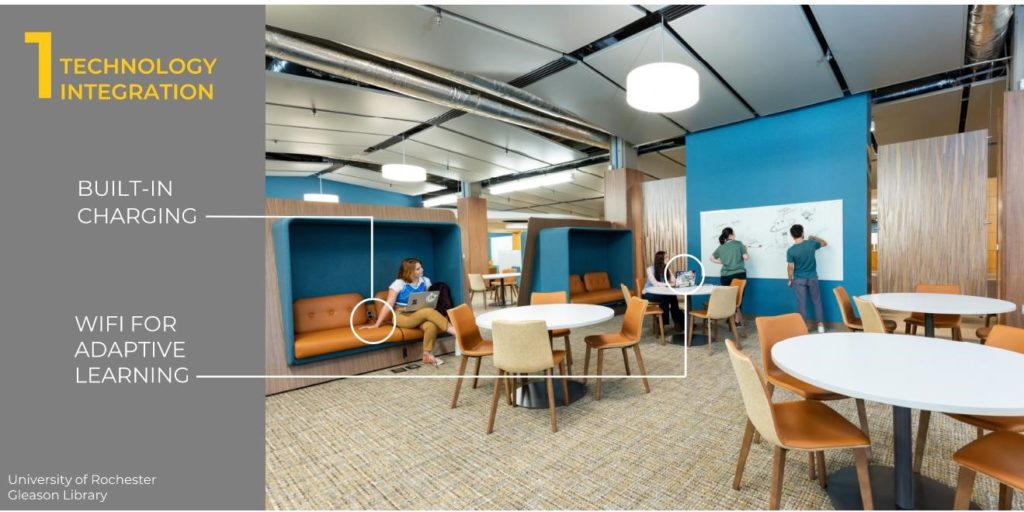
Green screens, Augmented Reality (AR) and Virtual Reality (VR) within the classroom can help students grasp difficult concepts by restructuring learning environments and delivering information in a manner more familiar to them. It can also allow them to “visit” and “explore” other countries or museums and interface with others – the possibilities are endless. This mode of information delivery promotes a better understanding of cultures, geography and global society, and as students become more frequently exposed to these types of technologies, unique career paths become increasingly tangible.
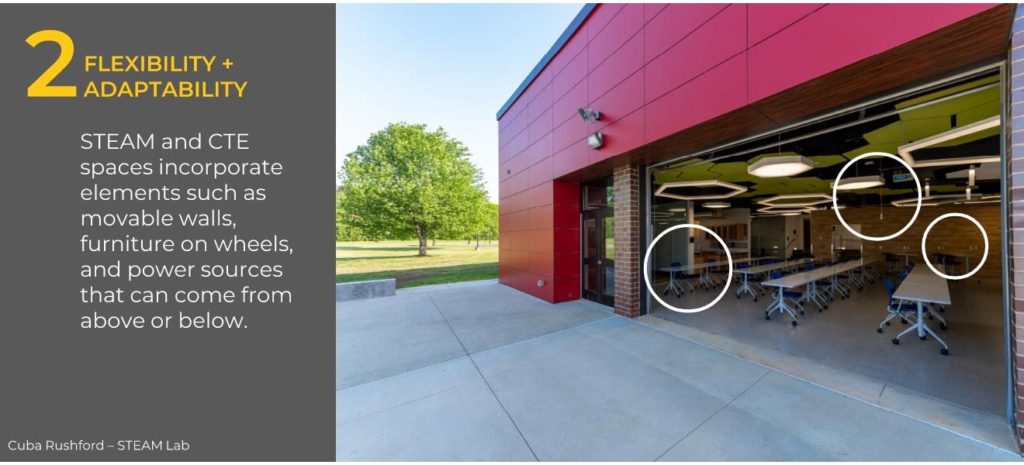
Flexibility and Adaptability
The ability to remain nimble to curriculum and classroom changes is best supported by the concept of flexibility and adaptability. Modular furniture, mobile displays and multi-purpose lab spaces are several examples of adaptive solutions that resolve changes in curriculum, scheduling and enrollment. This second key design element also supports diversity in learning styles, teaching pedagogy and project-based learning, which in turn enhance soft skills such as interpersonal communication and collaboration.
For Cuba Rushford Middle/High School, CPL designed a wing that can easily adapt to meet the needs of a wide range of programs and support a growing push for STEAM programming. Our team developed indoor and outdoor environments that serve several collaborative rooms as well as a central STEAM support lab, which transforms to accommodate the daily needs of a core project-based learning curriculum. The extension affords students new opportunities to develop professional skills in the realms of coding, robotics, culinary arts and presentation, setting them on a more enlightened path to the “next step.”
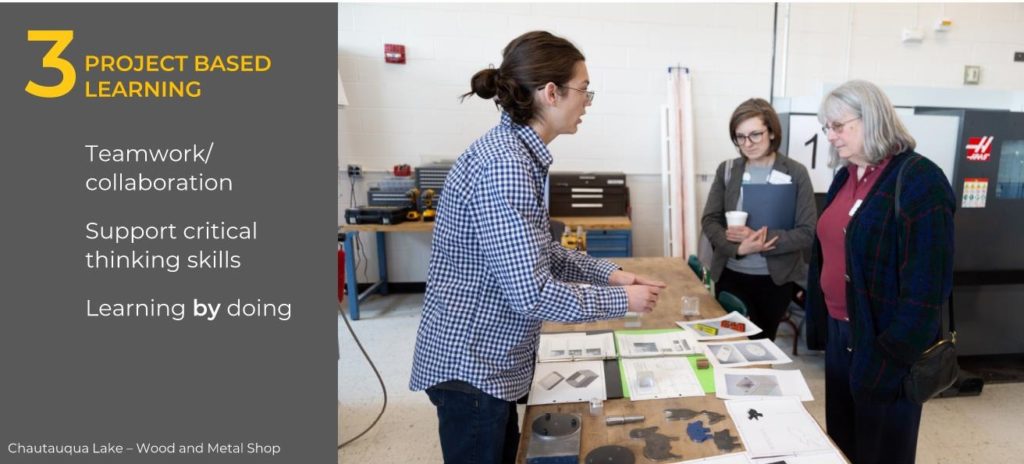
Project-Based Learning
Once a foundation is built using the aforementioned elements—technology integration and flexible/adaptive spaces—as key design factors, we can further increase support for students and educators by providing design for project-based learning environments, which promote teamwork and support critical thinking skills. Rather than tediously repeating information and hoping students will eventually memorize it, teachers can give them the resources they need to conduct hands-on research and apply practical concepts. Students become active rather than passive learners and acquire a “toolbox” of invaluable skills that will help them thrive in the workplace.
For Chautauqua Lake Central School, CPL created a classroom that could accommodate a diverse assortment of metal and wood shop projects. The space was designed to allow students to draft, prototype, test and finalize the fabrication and construction of real-world projects, which often translate to secondary degrees in fields such as industrial design or engineering—or alternatively, to immediate job placement following graduation.
These environments give students a first glimpse at a project’s more pragmatic facets, granting an early boost to their confidence, experience and professional skill development.
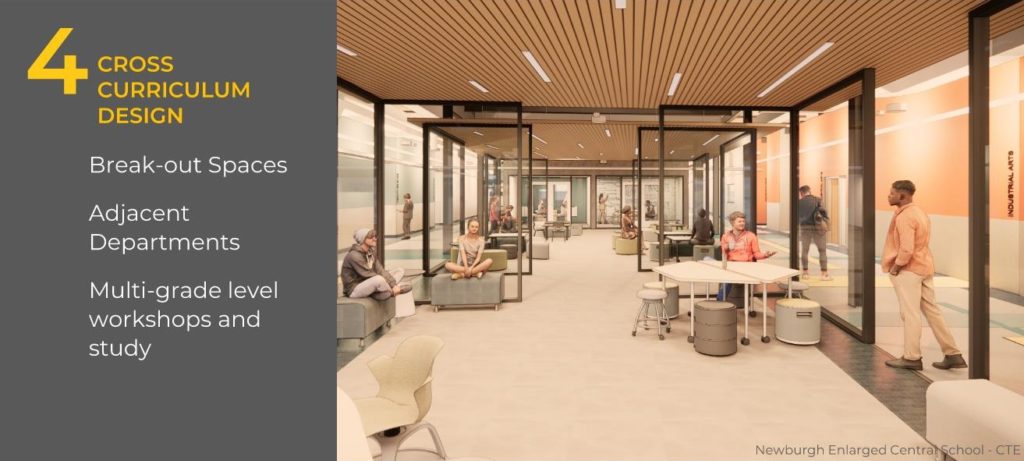
Cross-Curriculum Design
Like design for project-based learning, designing with cross-curriculum connections in mind can make education more meaningful for students—the material becomes relevant when they recognize similarities between individual disciplines.
At the Newburgh Central School District’s Career and Technical Education (CTE) School, CPL devised a plan to support cross-curriculum needs by designing breakout spaces to stimulate learning between previously separated classrooms and labs, and encourage engagement between different programs.
Classes involving computer-aided design (CAD) or graphic arts directly converge with learning and exploration in the fields of construction and welding. The cross-curricular investigations and assignments that include both programs demonstrate how educators can emphasize creativity and collaboration—both skills increasingly necessary for modern employment—between different students and subject areas and help them identify prospective career avenues.
There is strong evidence that CTE for at-risk students improves high school completion rates. Participation in CTE courses, especially as a concentrated program of study, may also increase students’ postsecondary education, employment and earnings.
The impact of these types of high-performance spaces on future success can be seen in studies conducted throughout the United States. According to a report by The County Health Rankings and Roadmaps at the University of Wisconsin Population Health Institute, “There is strong evidence that CTE for at-risk students improves high school completion rates. Participation in CTE courses, especially as a concentrated program of study, may also increase students’ postsecondary education, employment and earnings.”
Popular roles with competitive salaries that are championed by STEAM and CTE disciplines, such as coding, mathematics, robotics, graphic design and VR technology, include Software Developer, with a mean national salary of $81,519; Mechanical Engineer, with a mean national salary of $86,472; and Computer Programmer, with a mean national salary of $92,610, according to PayScale – all well above the national average of $74,378.
STEAM and CTE spaces also encourage careers in green technology and public works, which may encompass anything from developing electric vehicle infrastructure and renewable energy sources and ensuring city-wide energy efficiency compliance to developing more effective clean water systems and expanding high-speed internet to better accommodate society’s needs.
Moreover, the recent passing of the $1 trillion Infrastructure Investment and Jobs Act – which calls for the sweeping modernization of dated transportation networks, power grids and a wide array of other infrastructure systems – will create heightened demand for talent in technical fields, resulting in a promising job market for future STEAM and CTE school graduates.
The County Health Rankings and Roadmaps study also pointed out that taking more STEM-related CTE courses can reduce the frequency of school absences and chronic absenteeism, noting, “successful CTE programs identify high-growth industries, align CTE courses to specific skills and credentials, encourage CTE concentrations and make high school CTE credits count toward specific postsecondary credentials. Improving access to high-quality CTE schools and programs, creating consistent work-based learning opportunities and providing accessible information about careers to guide student choice are also recommended for successful CTE programs.”
As designers, we can play an active role in shaping the next generation by providing support for educators in ways that can be measured, seen and felt across the country. The changing job market and the shift towards globalization must be met by critical thinkers, innovators and problem solvers, and we will help our children be the ones to answer the call.

